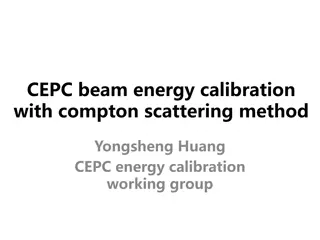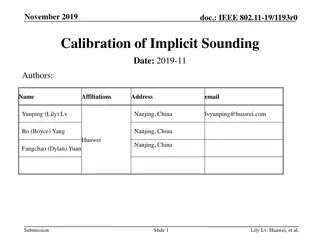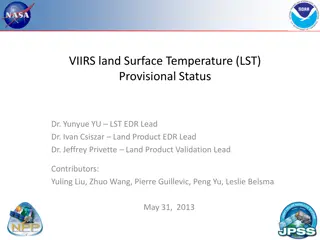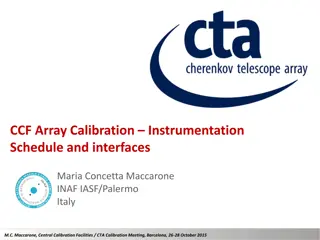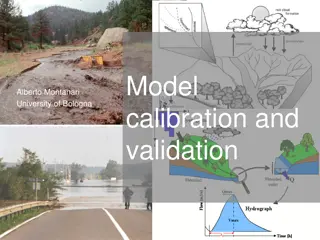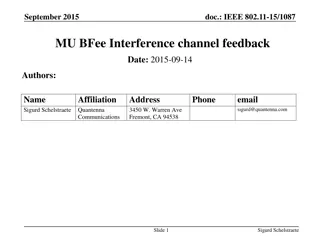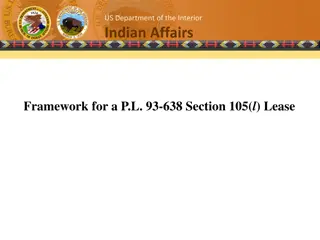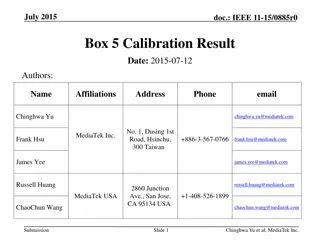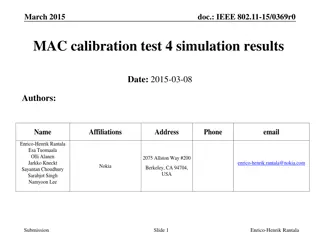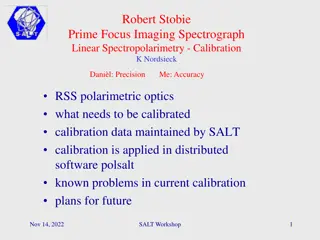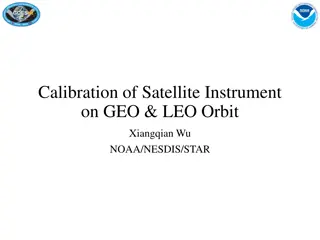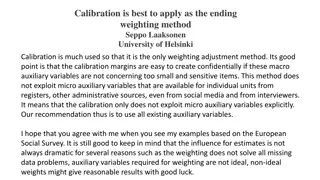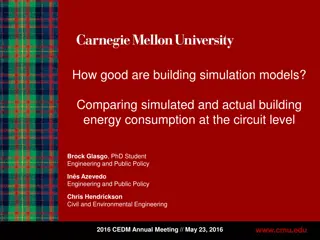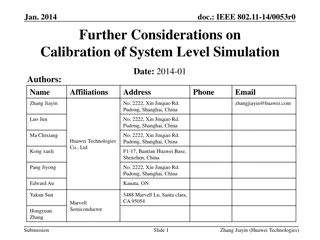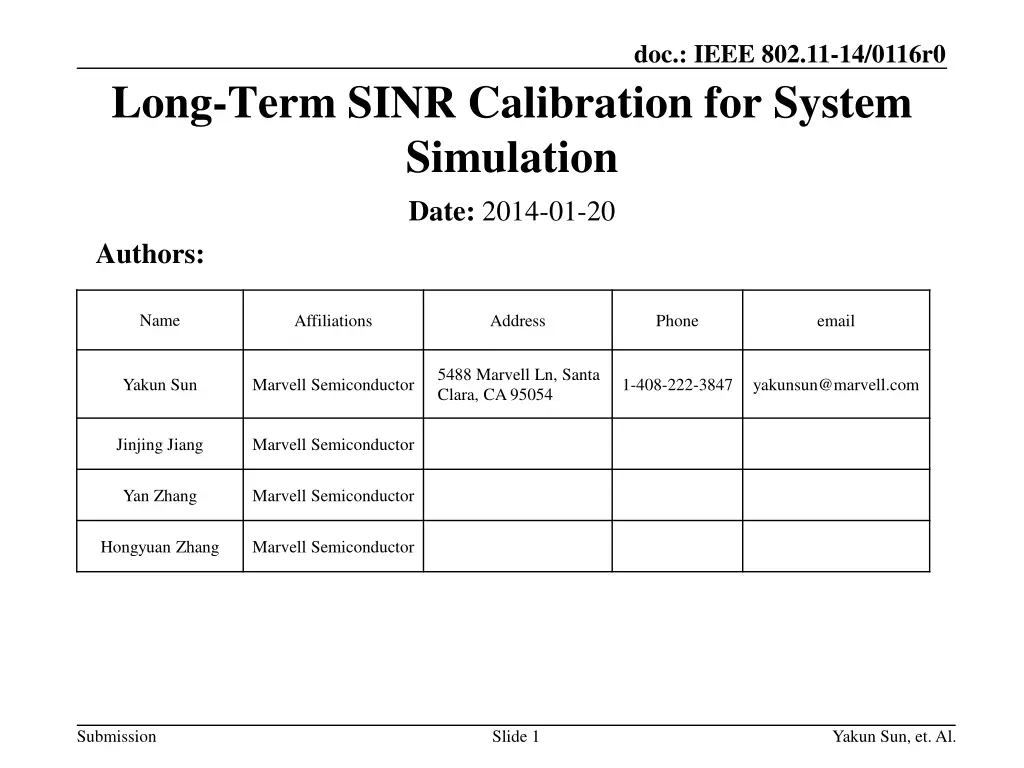
Long-Term SINR Calibration for System Simulation
Explore the proposal for long-term SINR calibration in system simulation for IEEE 802.11 standards. Understand the significance of long-term SINR in defining average reception quality and system modeling alignment. Discover the static radio characteristics and discussions on DL/UL traffic time ratio models related to long-term SINR in WiFi scenarios.
Download Presentation

Please find below an Image/Link to download the presentation.
The content on the website is provided AS IS for your information and personal use only. It may not be sold, licensed, or shared on other websites without obtaining consent from the author. If you encounter any issues during the download, it is possible that the publisher has removed the file from their server.
You are allowed to download the files provided on this website for personal or commercial use, subject to the condition that they are used lawfully. All files are the property of their respective owners.
The content on the website is provided AS IS for your information and personal use only. It may not be sold, licensed, or shared on other websites without obtaining consent from the author.
E N D
Presentation Transcript
doc.: IEEE 802.11-14/0116r0 Long-Term SINR Calibration for System Simulation Date: 2014-01-20 Authors: Name Affiliations Address Phone email 5488 Marvell Ln, Santa Clara, CA 95054 Yakun Sun Marvell Semiconductor 1-408-222-3847 yakunsun@marvell.com Jinjing Jiang Marvell Semiconductor Yan Zhang Marvell Semiconductor Hongyuan Zhang Marvell Semiconductor Submission Slide 1 Yakun Sun, et. Al.
doc.: IEEE 802.11-14/0116r0 Overview A step-by-step calibration was proposed in [1] with high level descriptions. More details and examples of the first step of statistics- based calibration in this contribution. Results also provide some insights of the simulation scenario under development. PHY statistics (Freq-domain SINR distribution) Simulation Scenario MAC calibration Static Radio statistics (S/I distribution) PHY Tput calibration Submission Slide 2 Yakun Sun, et. Al.
doc.: IEEE 802.11-14/0116r0 Static Radio Characteristics: Long Term SINR Geometry, or long-term SINR, defines the average quality of reception. Expected received (desired) signal power over the sum of the interference power (and noise). Expected received signal power of (desired or interfering) transmitter Include large scale fading (path-loss, shadowing factor) Include static transmission/receiving factors (transmit power, antenna gain, cable loss, noise figure, etc) Does not include small scale fading. Propose to use long-term SINR as a static radio characteristic for system simulator calibration. Long-term SINR provide a high-level picture of the network (deployment and basic transmitter/receiver/propagation configuration). Calibrating long-term SINR aligns the system modeling. Long-term SINR is easy to calibrate. Submission Slide 3 Yakun Sun, et. Al.
doc.: IEEE 802.11-14/0116r0 Definition of Long-Term SINR in WiFi Contention based channel access in WiFi leads to no strict definition of long term SINR. Some rough definition is used. A good definition should capture the deployment and long term radio statistics. Example: DL SINR of STA-m associated with AP-n AP n STA m P = SINR STA m 1 ( STA m ) ( STA m ) AP n AP k AP n STA i , , + + AP k STA m P STA i STA m P N ( ) k 0 DL UL N ( ) k k n i STA TX RX : expected received signal power from transmitter : percentage of time in DL (or UL) traffic in one BSS to receiver ( DL + P TX RX ) , 1 DL ( TX TX RX UL UL ) , : probability of collision of transmitter to at receiver TX TX RX 1 2 2 1 ( ) k ( ) k ( ) k = : Set of STAs assocated with AP- , and k N STA Submission Slide 4 Yakun Sun, et. Al.
doc.: IEEE 802.11-14/0116r0 Discussions on Long-Term SINR DL/UL traffic time ratio models Assume DL+ UL=1 a fully occupied network Case 1: DL: UL =1 equal traffic in both way Case 2: DL : UL =1:NSTA equal traffic from each STA including AP. Probability of collision roughly models CSMA 1 CSMA off ( RX ) , TX TX = ( ) 1 2 TX TX CSMA on U P CCA P 1 2 = 1 0 0 0 x x ( ) = U x Submission Slide 5 Yakun Sun, et. Al.
doc.: IEEE 802.11-14/0116r0 Tested Long-Term SINR 4 types of long-term SINR are tested in our contribution. AP n STA m P Equal UL/DL traffic, CSMA off 1 2 1 + + AP k STA m P STA i STA m P N ( ) k 0 N ( ) k k n i STA AP n STA m P Equal STA traffic, CSMA off 1 + + AP k STA m P STA i STA m P N ( ) k 0 + 1 N ( ) k k n i STA = SINR STA m AP n STA m P 1 Equal UL/DL traffic, CSMA on 1 2 ( ) ( ) + + AP k TA m AP n AP k STA i STA m P AP n STA i P U P CCA P U P CCA P N ( ) k 0 S N ( ) k k n i STA AP n STA m P Equal STA traffic, CSMA on 1 ( ) ( ) + + AP k STA m P AP n AP k STA i STA m P AP n STA i U P CCA P U P CCA P N ( ) k 0 + 1 N ( ) k k n i STA Submission Slide 6 Yakun Sun, et. Al.
doc.: IEEE 802.11-14/0116r0 Uplink Long-Term SINR Similarly, uplink long-term SINR can be defined as: Average UL SINR per AP 1 STA m AP n P ( ) n N ( ) 1 m n STA = SINR AP n ( AP n ) ( AP n ) STA m AP k STA m STA i , , + + AP k AP n P STA i AP n P N ( ) k 0 DL UL N ( ) k ( ) n ( ) n k n i m m STA UL SINR per AP-STA link STA m AP n P ( ) n = STA m AP n SINR for m 1 ( AP n ) ( AP n ) STA m AP k STA m STA i , , + + AP k AP n P STA i AP n P N ( ) k 0 DL UL N ( ) k ( ) n ( ) n k n i m m STA An example of uplink long-term SINR under equal STA/AP traffic with CSMA off STA m STA m AP n AP n AP k AP n k n STA N k + P = SINR 1 + + STA i AP n P P N ( ) 0 1 ( ) k i Submission Slide 7 Yakun Sun, et. Al.
doc.: IEEE 802.11-14/0116r0 Procedure of Statistics Collection The definition (and the parameters, such as UL/ DL and PCCA if apply) is selected and fixed before calibration. For the selected calibration scenario, multiple drops of STA/AP is done for convergence. In each drop: Drop STAs/APs, and associate each STA with an AP. Randomly drop or load prefixed locations. Fixed association or signal-strength based association After STA/AP are dropped and associated, collect the long-term SINR observed at each STA (downlink) and AP (uplink). After multiple drops: Generate the distribution (CDF) of long-term SINR for STAs (downlink) and APs (uplink) respectively collected over multiple drops. Submission Slide 8 Yakun Sun, et. Al.
doc.: IEEE 802.11-14/0116r0 Simulation Setup Simulation is based on scenario 1 to 4 in [2]. Distribution of downlink long-term SINR are plotted as an example. Detailed/optional simulation assumptions: 2.4GHz Channel with 20MHz Bandwidth Noise Figure: 7dB Thermal noise: -174dBm/Hz No antenna gain, no cable loss Expected received signal power is defined in Appendix. CCA threshold: -82dBm Randomly drop STAs and APs (if apply) Association based on scenarios (fixed for scenario 1-2, signal-strength based for scenario 3-4). Submission Slide 9 Yakun Sun, et. Al.
doc.: IEEE 802.11-14/0116r0 Scenario 1 Residential: SINR AP-AP, AP-STA and STA-STA: channel B 10 STA per BSS Scenario 1 is a severe interfered case (CSMA reduces interference by more than 20dB). Submission Slide 10 Yakun Sun, et. Al.
doc.: IEEE 802.11-14/0116r0 Scenario 2 Enterprise: SINR AP-AP, AP-STA and STA-STA: channel D Scenario 2 is a sever interfered case (CSMA reduces interference by about 20dB). DL/UL traffic impact SINR more with CSMA due to the limited number of strong interfering APs. Submission Slide 11 Yakun Sun, et. Al.
doc.: IEEE 802.11-14/0116r0 Scenario 3 Indoor Small BSSs: Received SINR AP-AP and AP-STA: channel-D STA-STA: channel B 30 STA per BSS Hexagon layout of reuse 3 Scenario is a severe interfered case (CSMA reduces interference substantially). DL/UL traffic impact SINR more without CSMA due to the large number of strong interfering APs. Submission Slide 12 Yakun Sun, et. Al.
doc.: IEEE 802.11-14/0116r0 Scenario 4 Outdoor Large BSSs: Received SINR AP-AP, AP-STA and STA-STA: UMi Penetration loss 20dB (outdoor-indoor) 50 STA per BSS (50% indoor) Hexagon layout of reuse 1 Scenario is a severe interfered case (CSMA reduces interference substantially). Using the same channel type for STA-STA causes a long tail for DL/UL=1/N (more severe interfering STAs) Submission Slide 13 Yakun Sun, et. Al.
doc.: IEEE 802.11-14/0116r0 Observations All types of long-term SINR give very good insights into the system modeling and captures fundamental characteristics for calibration. Long-term SINR distributions with different traffic model (UL/DL time ratio) are within a relatively small difference. Long-term SINR distributions with or without CSMA are with some dBs shift. We can select a type of definition solely based on complexity of calibration. Least ambiguity with equal STA/AP traffic and without CSMA. Submission Slide 14 Yakun Sun, et. Al.
doc.: IEEE 802.11-14/0116r0 Summary Use the distribution of long term SINR as the metric for system simulator calibration. For simplicity and avoiding ambiguity, use the definition with equal STA/AP traffic and without CSMA as the metric for calibration. Submission Slide 15 Yakun Sun, et. Al.
doc.: IEEE 802.11-14/0116r0 References [1] 11-13-1392-00-0hew-methodology-of-calibrating-system-simulation-results [2] 11-13-1001-05-0hew-HEW-evaluation-simulation-scenarios-document- template Submission Slide 16 Yakun Sun, et. Al.
doc.: IEEE 802.11-14/0116r0 Appendix: Expected Received Signal Power Received signal power at receiver RX from transmitter TX. ( ) ( ) ( ) ( ) ( ) ( ) ( ) = + + + + + TX RX P dBm P dBm G dBi PL dB SF dB G dB Scaling dB TX TX RX : transmit power : transmit/receive antenna gain : path loss : shadowing factor = P TX TX RX G / PL SF N 10log Scaling FFT 10 N _ used tones Submission Slide 17 Yakun Sun, et. Al.
doc.: IEEE 802.11-14/0116r0 Appendix: Scenario 1 Residential: Received Signal Power Submission Slide 18 Yakun Sun, et. Al.
doc.: IEEE 802.11-14/0116r0 Appendix: Scenario 1 Residential: Interference Signal Power Submission Slide 19 Yakun Sun, et. Al.
doc.: IEEE 802.11-14/0116r0 Appendix: Scenario 2 Enterprise: Received Signal Power Submission Slide 20 Yakun Sun, et. Al.
doc.: IEEE 802.11-14/0116r0 Appendix: Scenario 2 Enterprise: Interference Signal Power Submission Slide 21 Yakun Sun, et. Al.
doc.: IEEE 802.11-14/0116r0 Appendix: Scenario 3 Indoor Small BSSs: Received Signal Power Submission Slide 22 Yakun Sun, et. Al.
doc.: IEEE 802.11-14/0116r0 Appendix: Scenario 3 Indoor Small BSSs: Received Signal over white noise Submission Slide 23 Yakun Sun, et. Al.
doc.: IEEE 802.11-14/0116r0 Appendix: Scenario 3 Indoor Small BSSs: Interference Signal Power Submission Slide 24 Yakun Sun, et. Al.
doc.: IEEE 802.11-14/0116r0 Appendix: Scenario 4 Outdoor Large BSSs: Received Signal Power Submission Slide 25 Yakun Sun, et. Al.
doc.: IEEE 802.11-14/0116r0 Appendix: Scenario 4 Outdoor Large BSSs: Received Signal over white noise Submission Slide 26 Yakun Sun, et. Al.
doc.: IEEE 802.11-14/0116r0 Appendix: Scenario 4 Outdoor Large BSSs: Interference Signal Power Submission Slide 27 Yakun Sun, et. Al.



